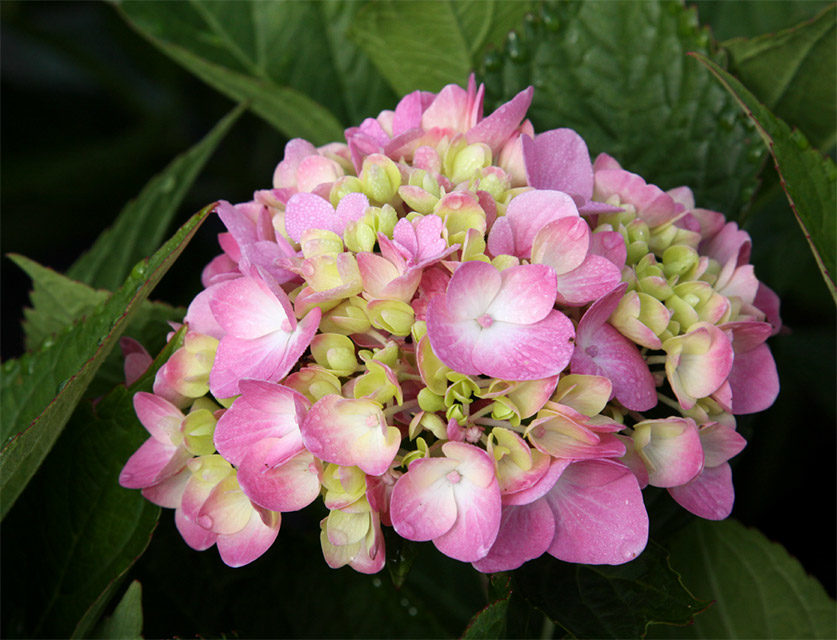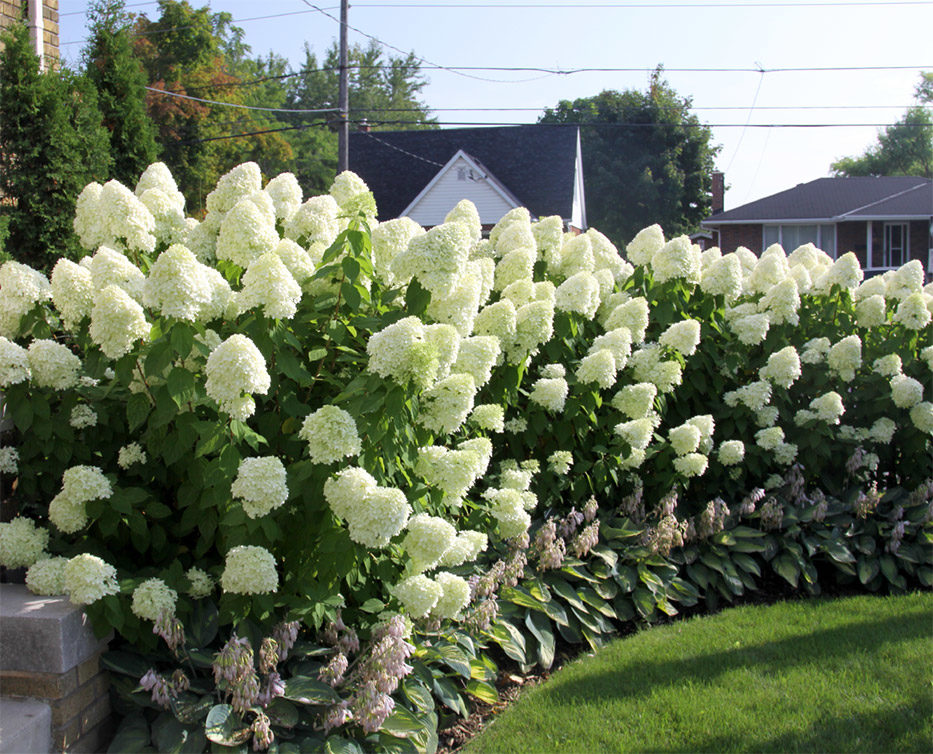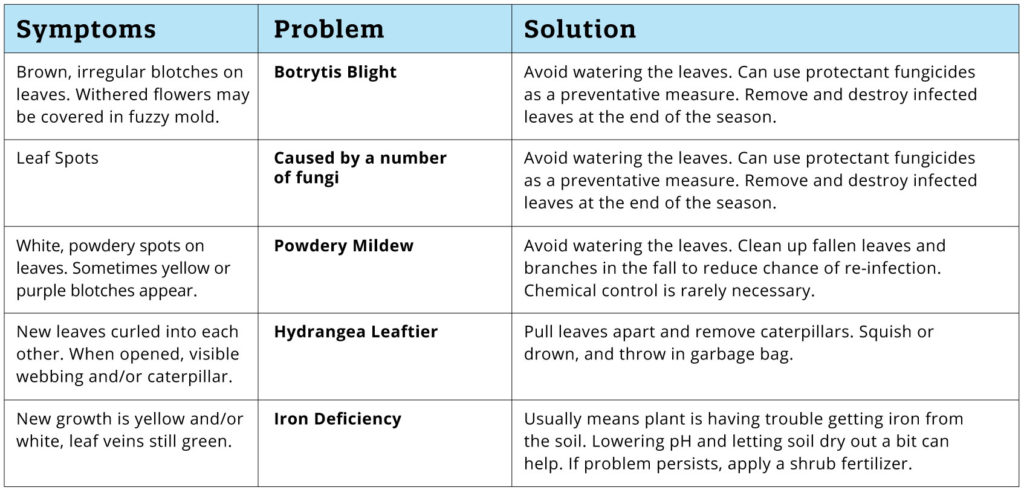TREES & SHRUBS
HYDRANGEAS
Hydrangeas have been growing in popularity, especially in recent years, and for good reason. They include a few different types that can thrive in different sun requirements, and with proper care, they put out an impressive show of blooms!
Types of Hydrangeas
Mophead or Bigleaf Hydrangea ("Macs")
Hydrangea macrophylla
Macs are one of the most popular hydrangea varieties, with blooms in shades of pink, purple, blue, and white. Since this hydrangea blooms on the previous year’s growth, it should only ever be pruned immediately after flowering and any dead wood can be cleaned up in the spring after the plant leafs out. This type benefits from winter protection to ensure new buds will not be damaged from the cold, and can be very sensitive to late spring frosts.
Common Varieties: Endless Summer series, Let’s Dance series, Cityline series

Smooth Hydrangea
Hydrangea arborescens
Hydrangea arborescens is native to Eastern North America, and includes the ever-so-popular ‘Annabelle’ Hydrangea. Known for its massive white blooms, Annabelles can be stunning in clusters and are very widely planted in both home and commercial gardens. Arborescens generally only come in white but there have been new cultivars introduced in recent years that come in shades of green and pink. This type blooms on new wood and benefits from being cut back heavily in the spring.
Common Varieties: Annabelle, Incrediball Blush, Invincibelle Wee-White

Panicle Hydrangea
Hydrangea paniculata
Paniculatas are an extremely cold hardy group of hydrangeas with long-lasting white flowers. Certain varieties have denser, cone-shaped blooms than others and some will even turn shades of pink later in the season. Bloom colour is not affected by PH. As a whole, they tend to be a little bigger than macrophyllas, but there are a few dwarf varieties. This type blooms on new wood and should be pruned back by ⅓ in late fall or early spring to encourage fuller, bushier growth.
Common Varieties: Limelight, Little Lime, Bobo, Vanilla Strawberry, Little Quickfire
Oakleaf Hydrangea
Hydrangea quercifolia
Native to the United States, this is an often overlooked species that definitely deserves more attention. Oakleaf Hydrangeas prefer part shade to shade, rather than sun, and size varies greatly by variety. Large white flowers appear in midsummer and turn shades of pink as they age, while the oak-shaped leaves have a great red fall colour. This type blooms on old wood and should only be pruned after flowering if necessary.
Common Varieties: Ruby Slippers, PeeWee, Jetstream, Gatsby series
Mountain Hydrangea
Hydrangea serrata
Hydrangea serrata are similar to mophead hydrangeas in their colour options, but are a smaller, more compact variety. There are few cultivars that can survive our winters and protection over the cold months is advised. Beautiful,delicate-looking lace cap blooms that will also change colour depending on the soil's PH. This type blooms on old wood and should only be pruned as needed on old wood.
Common Varieties: Tuff Stuff, Tiny Tuff Stuff, Tuff Stuff Red
Climbing Hydrangea
Hydrangea anomala subsp. petiolaris
Climbing Hydrangeas are a self-clinging woody vine with vigorous growth once established and white lacecap blooms that appear in early summer. It does need a strong support to grow on, and will do better on a solid wood fence or side of a building, than a trellis. This type blooms on the previous year's wood and should only be pruned after flowering so as to not cut off next year's buds.
Light
Though they can almost all take full sun (6-8 hours or more), most varieties do best with shade in the hottest parts of the day. Smooth, oakleaf, and climbing hydrangeas can also do well in full shade, while panicle hydrangeas handle full sun the best. Just remember, the more sun your hydrangea receives, the more water it will need to keep from wilting or browning
Water
Hydrangeas are considered a water-heavy plant and are prone to wilting quickly in the summer months, especially in the first 1-2 years while establishing its root system. In those first couple years, it is very important to soak the entire root ball when you water by holding the hose at the base of the plant. Remember that the roots are only the size of the pot you planted, so watering the surrounding garden space won’t do it any good. Once well established, watering can decrease to supplement rain in the hotter months, so potentially every few days to once a week, depending on how much sun it receives and how quickly it dries out.
Fertilizer
When fertilizing hydrangeas, remember less is more. Using a fertilizer with too much nitrogen will encourage foliage growth, but can result in little to no blooms. If you want to fertilize, try to choose a product with relatively low numbers, with the amount of phosphorus being higher than the amount of nitrogen in the fertilizer. To learn more about fertilizer and the purpose of different nutrients, check out our “Understanding Fertilizer” information sheet.
Pruning
One of the most common reasons why a hydrangea is not flowering is improper pruning. Mophead, Mountain, Oakleaf and Climbing hydrangeas almost all bloom on old wood, which means they will only flower on the previous year's growth. They set their buds for the following year shortly after they are done flowering (summer or fall). To be sure you don’t prune off the buds, only prune them immediately after flowering, rather than the following season, and only if the plant needs it. Some new varieties of mopheads bloom on old and new growth, but it is still best if they are pruned after flowering. Panicle hydrangeas only flower on new growth and should be pruned in early spring or late fall. This species also benefits from having ⅓ of their growth removed each year to encourage more flowers and a fuller shrub. Smooth hydrangeas also bloom on new growth and should be pruned back to 6” above the ground in either the spring or fall every year. This encourages bushier growth and stronger stems that will resist flopping.
Common Problems, Pests & Diseaseas





